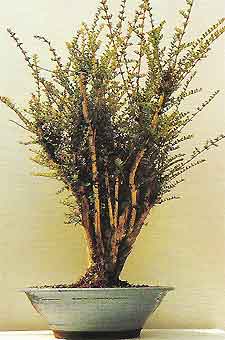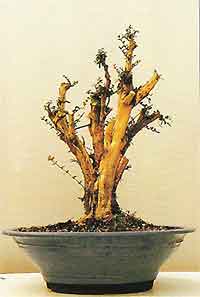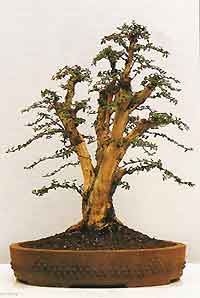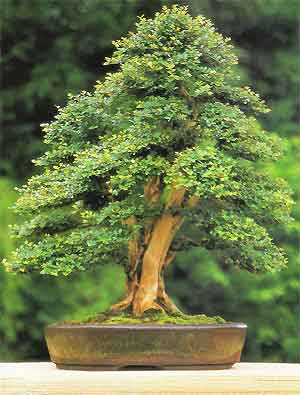Bonsai Trees
Case Histories
Lonicera Nitida - (dwarf honeysuckle)
Lonicera Bonsai Style: Triple Trunk

Garden hedges consist of different types of trees and shrubs, many of which make excellent bonsai material. If, when a hedge is removed, you are in the right place at the right time, then it is likely to be your lucky day. Seven years ago my lucky day arrived.
A shrub that makes an excellent dense evergreen hedge, being easy to clip and keep neat is lonicera nitida. There must be many potential bonsai specimens hidden in garden hedgerows. Driving past a house in a nearby village I noticed a lady digging up her lonicera hedge.

I stopped and politely enquired if it was her intention to dispose of any of the trees. She replied that they were all destined for the rubbish dump later that day.
I therefore rushed home to fetch my trailer and save her the trouble of taking the trees to the skip, collecting about two thirds of the trees. From this large selection, there were two loniceras that showed more potential that the rest. (Also, see next lonicera history).
Lonicera Bonsai History: Training
This lonicera had a large base and comprised of many separate trunks which were growing closely together. It had a good compact root system and so was repotted into a spare, deep bonsai pot that was ideal for training purposes. That year the tree grew with tremendous strength and I fed heavily to encourage this growth.

Thinking that the tree was only wasting energy growing so many shoots which were going to be pruned off after styling, it was thinned out and a basic structure set in place.
I removed several of the trunks that were beginning to grow together and the tree continued to grow strongly for the rest of the season. I wired many of the shoots at the end of the year.
The following spring I had a spare drum pot that I thought would suit the tree and so examined the rootball to ascertain how much I would be able to prune.
As I had expected, the tree was completely pot bound and the soil was full of roots. I was therefore able to root prune hard and still leave ample fibrous roots to support the tree.
That year the lonicera continued to grow well and I fed with high nitrogen ericaceous fertilisers, maintaining strong growth.

Three years later and I changed the pot to a slightly smaller, round pot that had a subtle blue glaze. I let the lonicera grow unchecked to help the branches thicken, so that they would appear more mature.
At the end of the season the tree had grown too wide and I wanted it to appear taller. I thinned the tree considerably and pruned hard, so that it would bud well the following spring, which it duly did.
 Garden hedges consist of different types of trees and shrubs, many of which make excellent bonsai material. If, when a hedge is removed, you are in the right place at the right time, then it is likely to be your lucky day. Seven years ago my lucky day arrived.
Garden hedges consist of different types of trees and shrubs, many of which make excellent bonsai material. If, when a hedge is removed, you are in the right place at the right time, then it is likely to be your lucky day. Seven years ago my lucky day arrived. I stopped and politely enquired if it was her intention to dispose of any of the trees. She replied that they were all destined for the rubbish dump later that day.
I stopped and politely enquired if it was her intention to dispose of any of the trees. She replied that they were all destined for the rubbish dump later that day. Thinking that the tree was only wasting energy growing so many shoots which were going to be pruned off after styling, it was thinned out and a basic structure set in place.
Thinking that the tree was only wasting energy growing so many shoots which were going to be pruned off after styling, it was thinned out and a basic structure set in place. Three years later and I changed the pot to a slightly smaller, round pot that had a subtle blue glaze. I let the lonicera grow unchecked to help the branches thicken, so that they would appear more mature.
Three years later and I changed the pot to a slightly smaller, round pot that had a subtle blue glaze. I let the lonicera grow unchecked to help the branches thicken, so that they would appear more mature.